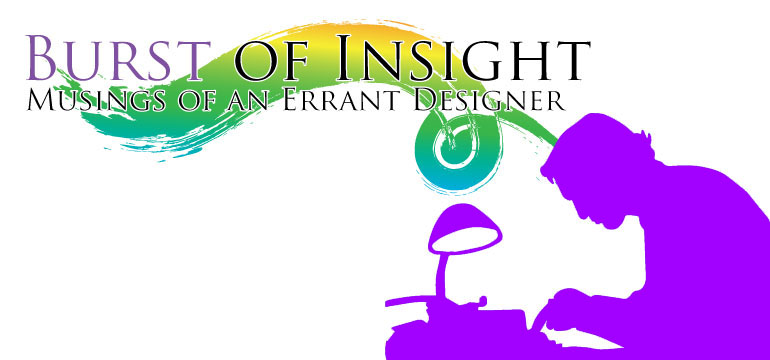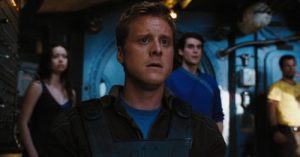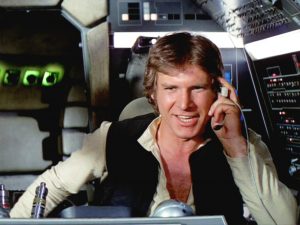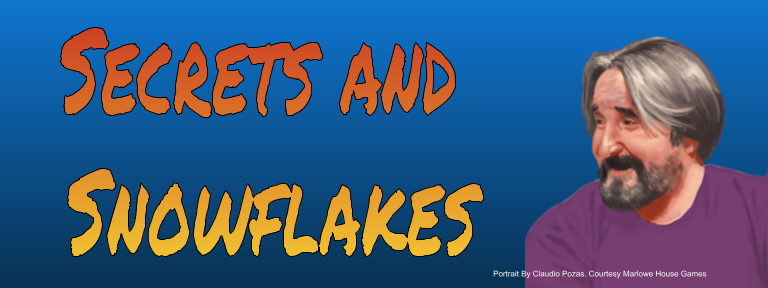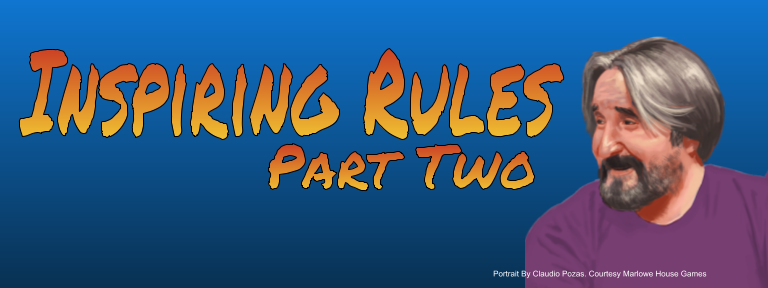So today we’ll talk a little about getting your game INTO space. That means starships and space stations. Since most games will involve parties of characters we’ll spend some time today starships that can be a mobile base for your campaign. For this we’ll look briefly into the vehicle rules from Anachronistic Adventures from Rogue Genius Games. Note this is a continuation of the kitbashing Starfinder series Monica kicked off on her last Inspire Confidence Blog you can read that entry here: System Kitbashing: Part One
The vehicle rules from Anachronistic Adventures are really designed to model the sorts of chase and action scenes you see in movies like Indiana Jones with older cars or early aircraft. But, it’s not hard to imagine those same scenes play out in space with more futuristic craft and the rules are pretty much just as flexible. The system offers rules for relative positions rather than trying to remain at the same scale as PC and monster movement. Most interestingly AA offers a vehicle template you can add to an existing monster from the bestiaries to turn it into a vehicle. Among other things this gives vehicles a CR, which simplifies creating encounters and setting a final CR for the encounter. I’ll build a starship with these rules later in today’s blog.
First however, we have a special guest joining us to talk about starship design from a map point of view as well as a little about cartography in general. We are joined today by ENnie winning cartographer Christopher West whose work has been seen in diverse gaming sources from pages of Dungeon Magazine to Monte Cooks award winning Numenera RPG. Chris also maintains his own website Maps of Mastery.
Chris, welcome to the Burst of Insight blog. Why don’t you tell us a little bit about what you’re currently doing.
Where to begin?! July is always my busiest month of the year as the race to illustrate and fund and print new maps in time for a Gen Con release hits critical mass. My plans for those maps changed late in the spring, so this year is even more hectic than usual. Right now I’m hastening to finish two new posters of my own, and a project for Gaming Paper:
My fourth Deck Space poster will offer deck plans of a genuine historical sailing warship (the Brig Niagara from the War of 1812) on one side, and empty ocean waves on the other side. Like my other Deck Space maps, it will include sheets of terrain bits that you can use to build your own encounters on the high seas.
My other personal work in progress is Deep Vistas IV, a new medieval fantasy-themed poster featuring an underground chasm stronghold and a labyrinthine serpent temple.
Meanwhile, I’m still putting the finishing touches on the black and white Megadungeon map pack: Alleys and Rooftops for Gaming Paper, another Gen Con release.
You mentioned that your map plans changed. What else were you working on?
My original plan was to produce a whole new level (four complete quadrants on four new double-sided posters) of the space station in my Distant Outposts map series. That’s still in the works, but has been postponed to become part of my next volume of maps.
Next volume?
Once Deep Vistas IV and Deck Space IV are completed, all of my current product lines will have four posters each. That will officially conclude what I’ve come to think of as the first full “volume” of my Maps of Mastery Omnibus—a PDF collection that contains of all of my self-published maps.
Once Volume 1 is complete, my goal is to start branching out into more genres by introducing a new series that includes modern and post-apocalyptic maps. I’ve also got plans for other new medieval fantasy locales that D&D and Pathfinder players will enjoy. But I’ve just got to return to some old favorites, which is where Distant Outposts V, VI, VII, and VIII come in: I’m having way too much fun exploring alien worlds and expanding my space station into a multi-deck capital ship to step away from sci-fi for long!
How did you get into cartography?
For as long as I can remember, I’ve had a love of maps. I picked up The Hobbit and The Lord of the Rings at a very early age, and was captivated by Tolkien’s world. I also remember making up map-based games in grade school to play with classmates. In college I majored in graphic design and tailored my portfolio towards the gaming industry.
When the RPG “Alternity” came out, I was so enamored of the starship deck plan in the Player’s Handbook that I tried to create a new ship in that same style. I sent it to Rob Lazzaretti, the lead cartographer for Wizards of the Coast at the time. He was so impressed with it that he tracked me down in a live Internet chat I was hosting to offer me his compliments. (Later, he would offer me some of my first paid work, designing diagrams for the final product in the Alternity line.)
Encouraged by this response, I started building a portfolio of mostly full-color maps, and took it to Gen Con the same year that Dragon and Dungeon magazines happened to be switching to a full-color format. The Editor, Chris Perkins, loved what he saw, and started sending work my way almost immediately. One of those early portfolio pieces was bought right away and used as the inspiration for an adventure. That became my first published map.
Can you tell us a little bit about your style?
Well, I got my start using a borrowed map style in order to teach myself how to make professional maps, but quickly realized that I needed to grow beyond that—especially when I started being asked to make official Star Wars maps at a scale for miniatures and even action figures. Soon my sci-fi maps started to take on more detail and incorporate more depth. There’s still a bit of iconic element to a lot of those maps: human-made objects and walls will typically have a crisp outline that keeps them from seeming photorealistic, but I think my style is best defined by the application of shadow and consistent directional lighting.
Do you approach fantasy and sci/fi maps differently?
Sort of. A lot of my fantasy maps, especially those scaled for miniatures, have evolved away from symbols and outlines, and towards a more natural-seeming quality.
With your Maps of Mastery you’re calling the shots rather than following someone else’s vision. Where do you get your ideas for that line? Are they things you just want to do “kinda just because” or are these resources you plan on using in your own games?
I do find a lot of inspiration for map ideas within my own RPG adventures. As a GM, I like memorable location-based encounters that inspire player characters (and their foes) to use the geography and the “set dressing” of an area in interesting and exciting ways. But at the same time I don’t assume that everyone is going to use a map for one specific encounter of my own design—so I prefer to create locations that can be useful again and again in different ways.
So about thirteen years ago I was running a d20 Star Wars. The adventures were framed a little bit like a television series drawing a huge amount of inspiration from Serenity and Cowboy Bebop including a starship in a starring role. The Nova Star was a Wayfarer-class freighter you did the cartography for Polyhedron (specifically 157 included in Dungeon Magazine 98). The visuals for that ship were really inspiring by its design and cartography. While I’m not inclined to restart that particular campaign I have been thinking about revisiting the themes of it and I think I found my replacement ship on your website. Care to guess which one that might be?
Would that be the Nova Eclipse, by any chance?
Yup the Nova Eclipse! So, what can you tell us about this ship? Not necessarily just about the map but about the ship itself.
Well, first of all I’ll confirm that the Nova Eclipse, or the “AR-37 Paragon-Class Light Transport” was absolutely designed with my older Wayfarer ship in mind. It’s meant to be a different make and model, but manufactured by the same shipbuilder using a similar design philosophy. Specifically, it’s got a detachable, side-slung compartment on the port side that can be swapped out with different modules that are optimized to carry different things: freight, VIP passengers, escort starfighters, etc. Special environmental adaptation kits exist, too, so you can get an AR-37 that functions underwater or in extreme temperatures.
The Nova Eclipse itself is a unique and highly customized AR-37 that has a few special tricks built-in. (In a lot of ways, it’s my own personal Millennium Falcon.) There’s a special system of ventilation ducts that can be used to not only sneak about the ship, but to vent select compartments into space if needed. It has multiple concealed smuggling areas, including one tucked away in those ceiling air ducts and another sandwiched between the detachable cargo pod and the main hull. It’s also sporting a rack of concussion missiles attached to the main dorsal laser turret—that’s definitely not standard issue! The Ion cannon turret on the starboard side probably isn’t, either.
Sterling Hershey has actually created game stats of the Nova Eclipse for Star Wars Saga Edition (WotC), West End Games D6 Star Wars, AND the current Star Wars Edge of the Empire system from Fantasy Flight Games. Here’s where you can find those:
http://www.sterlinghershey.com/blog/2012/5/9/star-wars-wednesday-nova-eclipse.html
http://www.sterlinghershey.com/blog/2015/9/16/star-wars-wednesday-maps-of-mastery-stats.html
I’m guessing you’ve played your share of d20 games. Do you play Pathfinder at all?
Yes, though it has been a while since I was able to put those books on the table. The other players in my group all have preferences towards various editions of other d20 fantasy RPGs, so when I’m running a game these days, it’s usually Star Wars.
So I’m guessing you’re not too familiar with the vehicle rules from Anachronistic Adventures?
Not really, honestly. I can’t say I’ve ever had the pleasure, though it sounds interesting!
So if you had to pick a monster to represent the nova star, what kind of monster would this be? Or what CR range do you think would be good.
Oh, gosh, I wouldn’t know where to start. Let’s see…it’s got to be something sturdy and adaptable. A real workhorse, but one that packs a punch and has one or more templates attached to make it more versatile. How about a Genie-Bound Clockwork Roc, with a variable Genie Boon depending on what role it’s serving in a given encounter. CR 12?
Well let’s see what something like that might look like: (note I’ve also added giant to get us to Colossal size)
Nova Eclipse CR 12
XP 19,200
Colossal metal vehicle
Init pilot; Sensors darkvision 120 ft., low-light vision
DEFENSE
AC 31 plus pilot, touch 6, flat-footed 30 (+4 deflection, +25 armor, –8 size)
hp 168 (16d10+80)
Saving Throw +5 plus pilot
Defensive Abilities Hardness 20/ adamantine; Resist acid 20, cold 10, fire 10, sonic 10; Weaknesses metal body, vulnerability to electricity
OFFENSE
Speed 40 ft., fly 320 ft. (average)
Melee 2 “talon” missile systems +30 (2d8+17/19–20), laser cannon +29 (2d10+17)
STATISTICS
Passengers: Crew 4, Passengers 16
“I Made a Few Modifications Myself” (Ex) Three times per day a member of the crew can choose to gain a +10 bonus on any one ship related skill check, gain a +5 bonus on a single ship saving throw it is required to make, or double the ship’s speed for a round. The pilot may choose to gain the bonus on a saving throw even on another creature’s turn. (From genie empowered)
Metal Body (Ex) The ship is largely composed of metal. It counts as a ferrous creature for the purpose of rusting grasp and other spells that have special effects on metal.
Reactive Systems (Ex) Pilot gains +4 to Initiative and a +1 dodge bonus to the ship’s AC while piloting the Nova Eclipse. (From Dodge and Improved Initiative feats)
Tactical Computer (Ex) An onboard tactical computer grants a +4 equipment bonus on all attack, damage, and Vehicular Combat Bonus (VCB) rolls. (Based on Djinni Boon)
Fuel: The Nova Eclipse can function for 21 continuous hours before needing to refuel.
That’s a pretty workable version of this ship. We’d need to likely tweak a few things here and there but I think it works pretty well. The big concern for me is the fuel and travel times. In the case of star-faring games I think you could shift hours to days and be pretty reasonable. Adamantine to get through the hardness seems unnecessary so I’d make its hardness simply 20. I might also play around with the genie boons, the tactical computer is a neat option but not the only possibility…Also, and amusingly, the genie empowered ability gives the ship a very Millennium Falcon sort of feel.
I’d like to thank Christopher West for taking the time to join us today if you have any questions or comments about today’s blog please let me know.

